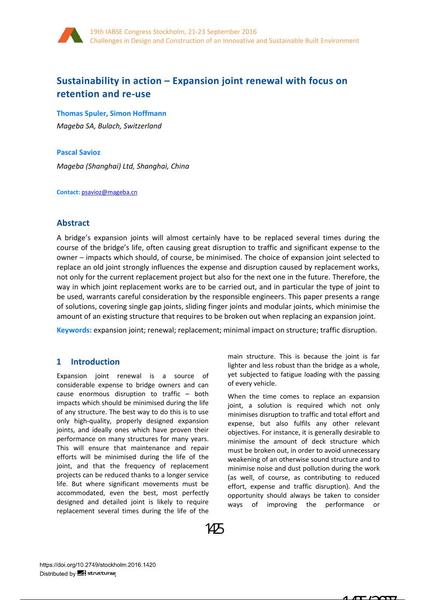Sustainability in action – Expansion joint renewal with focus on retention and re-use

|
|
|||||||||||
Bibliografische Angaben
| Autor(en): |
Thomas Spuler
(Mageba SA, Bulach, Switzerland)
Simon Hoffmann (Mageba SA, Bulach, Switzerland) Pascal Savioz (Mageba (Shanghai) Ltd, Shanghai, China) |
||||
|---|---|---|---|---|---|
| Medium: | Tagungsbeitrag | ||||
| Sprache(n): | Englisch | ||||
| Tagung: | IABSE Congress: Challenges in Design and Construction of an Innovative and Sustainable Built Environment, Stockholm, Sweden, 21-23 September 2016 | ||||
| Veröffentlicht in: | IABSE Congress Stockholm, 2016 | ||||
|
|||||
| Seite(n): | 1425-1432 | ||||
| Anzahl der Seiten (im PDF): | 8 | ||||
| Jahr: | 2016 | ||||
| DOI: | 10.2749/stockholm.2016.1420 | ||||
| Abstrakt: |
A bridge’s expansion joints will almost certainly have to be replaced several times during the course of the bridge’s life, often causing great disruption to traffic and significant expense to the owner – impacts which should, of course, be minimised. The choice of expansion joint selected to replace an old joint strongly influences the expense and disruption caused by replacement works, not only for the current replacement project but also for the next one in the future. Therefore, the way in which joint replacement works are to be carried out, and in particular the type of joint to be used, warrants careful consideration by the responsible engineers. This paper presents a range of solutions, covering single gap joints, sliding finger joints and modular joints, which minimise the amount of an existing structure that requires to be broken out when replacing an expansion joint. |
||||
| Stichwörter: |
Erneuerung Fahrbahnübergangskonstruktion (FÜK)
|
||||
